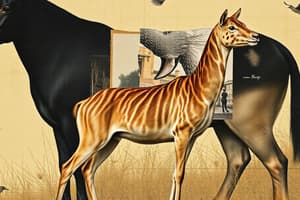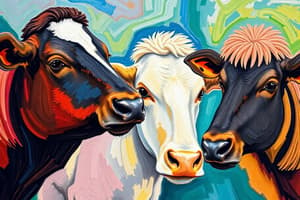Podcast
Questions and Answers
Animal science is primarily concerned with food production.
Animal science is primarily concerned with food production.
True (A)
What percentage of food expenditure was reported in the US in 1990?
What percentage of food expenditure was reported in the US in 1990?
- 43% (correct)
- 6%
- 30%
- 11.9%
Define domesticated animals.
Define domesticated animals.
Animals that have been selectively bred and genetically adapted for human use.
The Magnificent 7 refers to the seven key domesticated animals: Dog, Cat, Horse, Pig, Chicken, Sheep, and ______.
The Magnificent 7 refers to the seven key domesticated animals: Dog, Cat, Horse, Pig, Chicken, Sheep, and ______.
What is the primary purpose of monogastric digestive systems?
What is the primary purpose of monogastric digestive systems?
Which digestive system is characterized by herbivores having multiple stomach chambers?
Which digestive system is characterized by herbivores having multiple stomach chambers?
Continuous feeders, like horses, primarily consume high __________ diets.
Continuous feeders, like horses, primarily consume high __________ diets.
What role do proteins play in the nutrient requirements of animals?
What role do proteins play in the nutrient requirements of animals?
Which of the following is an example of an invasive species?
Which of the following is an example of an invasive species?
Why is animal science important?
Why is animal science important?
What does animal science include?
What does animal science include?
The American Society of Animal Science was started in 1908.
The American Society of Animal Science was started in 1908.
Without domestication, humans would still be __.
Without domestication, humans would still be __.
What are the Magnificent 7 animals associated with early domestication?
What are the Magnificent 7 animals associated with early domestication?
Match the digestive systems to their corresponding types:
Match the digestive systems to their corresponding types:
What is the main difference between continuous and discontinuous feeders?
What is the main difference between continuous and discontinuous feeders?
Carnivores have the longest digestive tract compared to omnivores.
Carnivores have the longest digestive tract compared to omnivores.
What is the role of the cecum in herbivores?
What is the role of the cecum in herbivores?
What nutrient is considered a limiting resource in animal diets?
What nutrient is considered a limiting resource in animal diets?
Flashcards are hidden until you start studying
Study Notes
Animal Science Importance
- Animal science focuses on animal production, zoology, research, and veterinary medicine.
- Animal products provide food, clothing, transportation, and other resources.
- The consumption of animal products has decreased over time, but the challenge of feeding a growing population remains.
- The American Society of Animal Science was founded in 1908.
Domestication and Wild Animals
- Wild animals are not domesticated or tame.
- Domesticated animals are selectively bred, genetically adapted for human purposes.
- Feral animals are domesticated species reverted to a wild state.
- Tame animals tolerate human presence.
- Introduced species are not native but are considered beneficial.
- Invasive species are not native and cause damage.
- Domestication enabled the development of civilizations.
Domestication Theories
- Intentional Domestication: Deliberate control of breeding, specialization, and genetic segregation from wild species (e.g., sheep, goats, cattle, horses).
- Self Domestication: Species adapting to human environments (e.g., mice, dogs, pigs, cats).
Digestive Systems and Strategies
- Nutrient Requirements: Water, energy, protein, vitamins, and minerals.
- Continuous Feeders: Grazing animals that consume high fiber, low digestible forages, relying primarily on microbial digestion (e.g., horses).
- Discontinuous Feeders: Carnivores and omnivores that consume high-quality food in bulk, primarily using chemical digestion (e.g., lions, humans).
- Types of Digestive Systems:
- Monogastric: Carnivores and omnivores have a single stomach (e.g., pigs).
- Ruminant: Herbivores with four-chamber stomachs for microbial digestion (e.g., cows).
- Non-Ruminant Herbivore: Herbivores with a single stomach but modified for microbial digestion (e.g., horses)
- Modified Monogastric (Avian): Birds have modified digestive systems (e.g., chickens).
- Common Digestive Features:
- Prehension: Grabbing food with hands or mouth.
- Mastication: Breaking down food with teeth.
- Digestion: Chemical and microbial breakdown of food.
- Absorption: Nutrient uptake.
- Elimination: Excretion of indigestible materials.
Monogastric Digestive System
- Esophagus: Transports food from the mouth to the stomach as a bolus.
- Stomach: Chemical digestion occurs with gastric fluids and enzymes, creating a low pH environment.
- Small Intestine: Divided into two parts, the proximal region responsible for digestion and the distal region for nutrient absorption.
- Large Intestine: Absorbs water and excretes waste.
- Cecum: A blind pouch present in some animals for microbial digestion (e.g., pigs).
- Appendix: A non-functional cecum in humans.
Herbivore Digestive System
- Esophagus: Allows two-way movement of partially digested food, enabling rumination for further mechanical breakdown.
- Reticulum: A honeycomb-like chamber in the stomach, assisting in food sorting.
- Rumen: The largest stomach chamber, containing a complex microbial community for digestion.
- Omasum: Absorbs water and minerals.
- Abomasum: The true stomach, where chemical digestion takes place.
- Large Intestine: Absorbs water.
- Cecum: Microbial digestion occurs here, providing additional energy.
Animal Science Importance
- Animal science is crucial for food production, with animals providing diverse products beyond meat, including milk, leather, fiber, and even industrial materials.
- Animals contribute to transportation and agriculture.
- The US spent 6% of its total budget on food in 2023, highlighting the significance of animal science in addressing global food security.
- Animal science also encompasses research, veterinary medicine, and zoological practices.
- The pet industry is a substantial market, exceeding $150 billion in annual spending, reflecting societal priorities and providing insight into pet health trends.
- The American Society of Animal Science, founded in 1908, drives research and promotes advancements in animal husbandry.
Wild Animals, Domesticated Animals, and Feral Animals
- Wild animals are naturally occurring and not subjected to human manipulation.
- Domesticated animals are selectively bred, genetically adapted, and serve human purposes.
- Feral animals are domesticated species that have reverted to a wild state.
- Tamed animals exhibit tolerance towards human presence, regardless of their domestication status.
- Introduced species are non-native to their environment but are considered beneficial.
- Invasive species are non-native and cause harm to their environment.
Domestication Importance
- Domestication enabled the transition from hunter-gatherer societies to civilizations.
- The "Magnificent Seven" – dog, cat, horse, pig, chicken, sheep, and cow – represent the most impactful domesticated animals.
Domestication Theories
- Intentional Domestication: This theory proposes deliberate control and targeted breeding for specific traits, leading to genetic isolation from wild counterparts.
- Self Domestication: This theory suggests animals became domesticated through interactions with humans, such as scavenging from village dumps, followed by selective breeding.
Digestive Systems
- Nutrient Requirements:
- Water: A crucial, often limiting, resource for animals.
- Energy: Required for bodily functions and activities.
- Protein: Essential for growth, development, and tissue repair.
- Vitamins: Organic compounds needed in small amounts for various physiological processes.
- Minerals: Inorganic elements vital for bone formation, fluid balance, and other functions.
- Types of Digestion:
- Continuous Feeders: Animals graze continuously throughout the day, consuming fibrous, low-digestible diets.
- Discontinuous Feeders: Organisms consume large quantities of high-quality food at intervals, relying more on chemical digestion.
Digestive System Categories
- Monogastric: Single-stomached animals with a primarily chemical digestion system.
- Include carnivores and omnivores.
- Example: Pigs and dogs.
- Ruminant: Possess multi-chambered stomachs, predominantly herbivores.
- Significant microbial digestion.
- Example: Cows and goats.
- Non-Ruminant Herbivore: Single-stomached herbivores with adaptations for microbial digestion.
- Example: Horses.
- Modified Monogastric (Avian): Have special adaptations in their digestive tracts.
- Example: Chickens.
Digestive System Components
- Prehension: Process of obtaining food using hands, mouth, or other specialized structures.
- Mastication: Chewing and breaking down food for digestion.
- Digestion: Chemical and/or microbial breakdown of food.
- Absorption: Uptake of nutrients into the bloodstream.
- Elimination: Removal of undigested waste products.
Studying That Suits You
Use AI to generate personalized quizzes and flashcards to suit your learning preferences.




